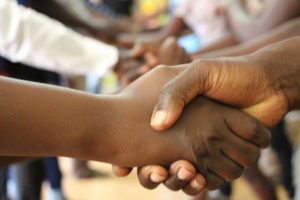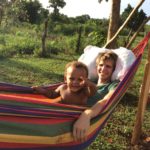Minds of the Movement
An ICNC blog on the people and power of civil resistance
by Phil WilmotMarch 25, 2020
Amassing our power and taking nonviolent action against oppression is the most important and urgent work of our time. As with other skills, becoming more knowledgeable about how to do this effectively should help us reach our goals.
I have spent the past decade committed to training people in civil resistance and supporting the growth of training teams that can build power within their own communities. I have developed curricula for movements, unions, and organizations. I’ve spent countless hours organizing and fundraising for nonviolent resistance training programs. I’ve trained organizers and activists in many countries, using all kinds of traditional and experimental modalities—online classes with students enrolled across more than 70 countries, direct action simulations with rural youth and farmers, strategic campaign planning with unionists, open space storytelling, collaborative workshops with fellow organizers, and more. I know the transformative potential that this type of education has.
Yet, nothing is guaranteed. I have to be honest with myself that in some cases training does not yield its intended impact. A team of trainers I was coaching a few years ago at Solidarity Uganda was conducting hefty monitoring and evaluation on movement training impact, and the results were sometimes counterintuitive. For example, brief trainings that we had scrambled to put together at the last minute were poorly executed, yet many of their participants became high-impact activists thereafter. On the other hand, week-long intensive trainings that had been meticulously planned often did not generate the desired results. Sometimes we actually witnessed a decline in trainees’ commitments to their causes after they went through one of our trainings.
“We are giving them all the support they need,” I told a colleague. “Why are some idle, while others are unexpectedly blossoming?”
What determines impact?

Identifying participants in a deliberate manner is a major determinant in training outcomes. Source: Solidarity Uganda.
Those of us who educate, whether in informal environments or in the classroom, would like to believe that our curriculum and how we present it directly determines the extent to which our participants thrive. While this may be partially true, these factors are far from being the most important determinants of a participant’s success.
Although very little research has been done on civil resistance training in particular (with a few exceptions like this one), we have observed that the pedagogies associated with this type of training are closely related to those of adult education. A study by learning expert Robert Brinkerhoff suggests that although approximately 90% of resources are invested in the delivery of a training event, post-event support is the largest determinant of learning. This includes the environment to which learners return. The second largest determinant pertains to actions taken prior to a learning event. In other words, most of our time, energy, and funds are being invested in the point in the training cycle that has the lowest impact on learning!
Brinkerhoff thus developed a 40/20/40 training model: 40% of our efforts focusing on activities before the training, 20% on the training itself, and 40% on activities after the training.
The actual content and facilitation of a training has less of an influence on a training’s impact on participants and their communities than we educators would like to believe. In my own cohort of trainers, some of the most important principles these realizations have led us to adopt are:
- Identify participants deliberately;
- Solicit buy-in from participants before and after training them;
- Blur the dichotomy of reflection and action to increase applicability of what is learned to real life.
Identifying participants

Requiring some kind of buy-in or responsibility on behalf of training participants builds trust and solidarity. Source: Solidarity Uganda.
Under pressure to meet funder requirements (due to the NGOization of resistance), training providers’ priorities in participant selection are sometimes reduced to simply ticking gender quotas. This makes it difficult to comprehend the more complex spectrum of factors involved in getting the right people into the room together.
Through reflection and experimentation with these factors, Solidarity Uganda trainers have become more deliberate about how we identify, filter, and select participants. Here is one way we've made our participant selection process more deliberate and meaningful:
- Form a three-person task force comprised of at least one person who knows the potential participants well and at least one person who will be facilitating the upcoming training.
- List each potential participant, and determine how many participants you want (and why that number).
- Score each potential participant out of 10 possible points. We have used the following system, but you can develop one suitable to your own contextual considerations and needs:
- 0 to 6 points for “are they already organizing on relevant issues;”
- 0 to 3 points for “do they represent a demographic most victimized by the injustices they are fighting;”
- 0 to 1 point for “are they not a male.”
(Our strategy here is to weigh a potential participant’s organizing capital and track record even more heavily than other factors we also considered important.) - Those with top scores (to be kept confidential) are invited to the training, and ideally given modest reading assignments or tasks beforehand to help them prepare. Those who arrive having fulfilled these tasks adequately will immediately stand out to trainers as those worthy of more deliberate mentoring.
Soliciting buy-in

When we make action more reflective, and reflection more active, we ensure that participants can immediately apply what they learned to their everyday lives. Source: Solidarity Uganda.
Another option is to require some kind of buy-in to your training. An application process will make participants feel as though they’ve been granted a special opportunity. An appropriate training fee (usually based on a sliding scale beginning from a contribution for the cost of one’s lunch up to $100) for participants will help ensure that they want to be there. Such approaches are not always possible and advantageous in every case, but for certain trainings, they are likely to increase the odds that participants will gain something helpful from the experience.
Some training groups like Australia’s Plan to Win have bartered for goods in exchange for their services as another form of buy-in. Solidarity Uganda’s regional trainers are available for ongoing support for those they have trained, and the latter are expected to host a trainer who comes to consult members on the ground. Requiring some kind of buy-in or responsibility on behalf of participants not only ensures they have “a dog in the fight,” but also builds trust and solidarity, which will help trainees stay connected to trainers as they apply what they have learned and encounter challenges.
Blurring the dichotomy of reflection and action
Brazilian educator Paulo Freire developed a “pedagogy of the oppressed,” which was rooted in praxis—the synthesis of reflection and action. Disillusioned with high-cost trainings delivered powerfully but that produced low impact, and bewildered by seemingly ineffectual trainings that surprisingly resulted in extraordinary activism, members of Solidarity Uganda decided to take Freire’s theory to the next level and fuse reflection and action into one compounded activity.
Women’s bicycle caravans in western Uganda have at once defied a cultural taboo against women riding bikes, while simultaneously conscientizing community members on feminism, patriarchy, and how to organize in pursuit of the community’s rights and interests. In Angola, a book club convened by musicians, academics, and their allies at once disobeyed an unjust law while also generating the kind of reflection that contributed massively to the fall of dictator Jose Eduardo dos Santos.
Integrating training within the modality of action—or action within the modality of training—helps us break free from the prevalent practice of organizing mere “nice to know” trainings. When we make action more reflective, and reflection more active, we ensure that participants can immediately apply what they learn to their everyday lives.
__
To supplement the countless curricula and training materials that already exist, more hard research is needed on the impact of nonviolent resistance training. But in our many years of operation in the field, we have come to understand that taking the steps discussed here as trainers helps all of us, as ordinary people, to build our power.

Phil Wilmot
Phil Wilmot is a former ICNC Learning Initiatives Network Fellow, co-founder of Solidarity Uganda, and a member of the Global Social Movement Centre and Beautiful Trouble. Phil writes extensively on resistance movements and resides in East Africa. Write to Phil at phil@beautifultrouble.org.
Read More